Coronavirus (COVID-19): modelling the epidemic (issue no.109)
Latest findings in modelling the COVID-19 epidemic in Scotland, both in terms of the spread of the disease through the population (epidemiological modelling) and of the demands it will place on the system, for example in terms of health care requirement.
Coronavirus (Covid-19): modelling the epidemic in Scotland (Issue No. 109)
Background
This is a report on the Scottish Government modelling of the spread and level of Covid-19 in Scotland. This updates the previous publication on modelling of Covid-19 in Scotland published on 15th September 2022. The estimates in this document provide an overview of the situation regarding the virus and help the Scottish Government, the health service and the wider public sector plan ahead.
Key Points
- The reproduction rate R in Scotland is currently estimated as being between 0.8 and 1.1, as at 13th September. The lower limit has decreased since the last publication while the upper limit is unchanged.
- The daily growth rate for Scotland is currently estimated as between ‑4% and 1% as at 13th September. The lower limit has decreased since the last publication while the upper limit is unchanged.
- The percentage of people who had taken at least one lateral flow test in the previous 7 days was 26%. This is similar to the previous wave of the survey (1st - 7th September), where the percentage was 25%.
- The SPI-M-O consensus view is that by 25th October, daily hospitalisations from Covid-19 in Scotland are estimated to be between 14 and 96, and hospital occupancy is estimated to be between 274 and 790.
- Analysis by the Edinburgh University Roslin Institute indicates that there remains a substantial variation in geographical risk of infection when considering the average recorded census age and booster vaccination uptake.
Overview of Scottish Government Modelling
Modelling outputs are provided here on the current epidemic in Scotland as a whole, based on a range of methods. Because it takes a little over three weeks on average for a person who catches SARS-CoV-2 (the causative agent of Covid-19) to show symptoms, become sick and either die or recover, there is a time lag in what our model can tell us about any changes in the epidemic.
The Scottish Government presents its modelling outputs to the Epidemiology Modelling Review Group (EMRG). These outputs are included (shown in green) in Figure 1. Outputs from other modellers are shown in either cyan (for models based only on cases data) or purple (for models based on other data). The UKHSA consensus range is the rightmost (in red).
The R value and growth rates are also estimated by several independent modelling groups based in universities and the UKHSA. Estimates are considered, discussed and combined at the EMRG, which sits within UKHSA. These are based on data up to 26th September.
The consensus view of the UKHSA across these methods was that the value of R in Scotland is between 0.8 and 1.1 as of 13th September 2022 (Figure 1). The lower limit has decreased since the previous publication, while the upper limit is unchanged. R is an indicator that lags by two to three weeks.
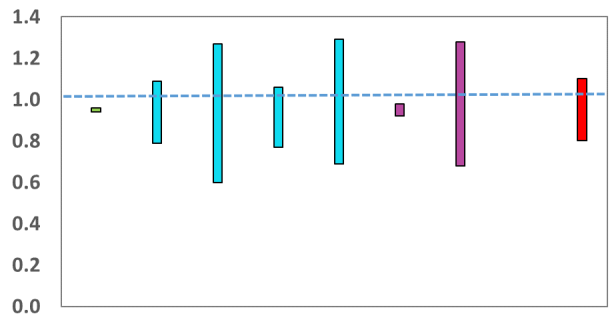
Source: EMRG
The consensus from UKHSA is that the growth rate in Scotland is between -4% and 1% per day as at 13th September. The lower limit has decreased since the last publication while the upper limit is unchanged.
UKHSA was unable to reach a consensus on the incidence of new daily infections in Scotland as at 13th September.
What we know about how people’s contact patterns have changed
Scottish Contact Survey contact matrices are now published as open data. The dataset contains mean contacts between age groups for all waves of the survey since its inception in August 2020 and will be updated fortnightly to add data for the latest survey wave.
The most recent wave of the Scottish Contact Survey (15th - 21st September) indicates an average of 6.4 contacts. This has remained at a similar level compared to the previous wave of the survey (1st - 7th September) where average contacts were 6.5, as seen in Figure 2.
Prior to the Covid-19 pandemic, the average daily contacts for adults in the UK were reported to be 10.8 from the UK-wide POLYMOD study[1].
Mean contacts in the work setting have decreased by 16%, whilst mean contacts in the other setting (contacts outside home, school and work) have increased by 6%. Mean contacts in the home have remained at a similar level over the same period.
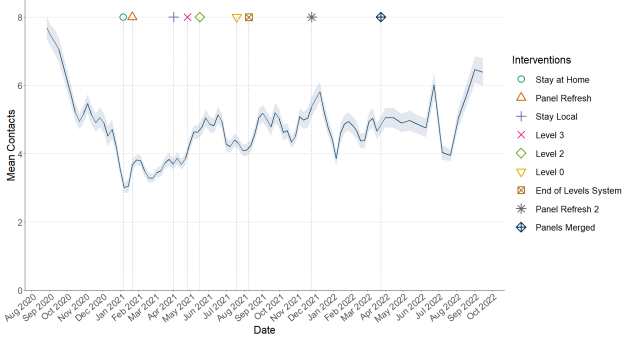
Figure 3 shows how contacts change across age group and setting. Mean contacts have increased in those aged between 30-39 and those aged 70 and over, by 20% and 9% respectively. Mean contacts in the 50-59 age group have decreased by 26% over the same period.
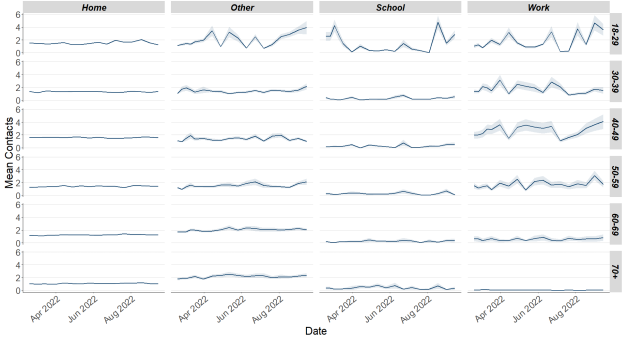
The heatmaps in Figure 4 show the mean overall contacts between age groups for the surveys relating to 1st - 7th September and 15th - 21st September and the difference between these periods. The highest average number of interactions are observed between the 18-29 age group and those under the age of 18.
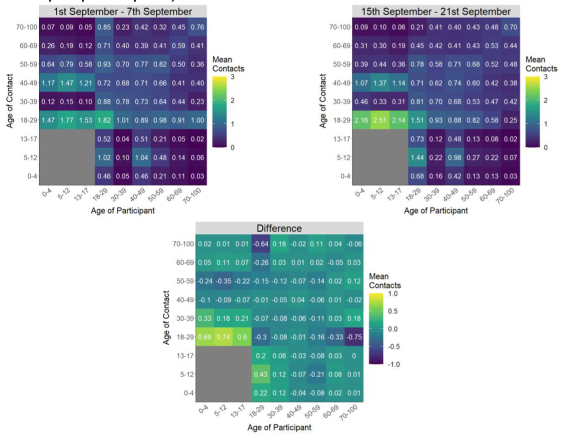
The largest increase in the proportion of participants visiting different locations is seen in those visiting another person’s home and the biggest decrease in those using public transport. The percentage of participants visiting another person’s home has increased from 51% to 56%, whilst the percentage using public transport has decreased from 36% to 33%.
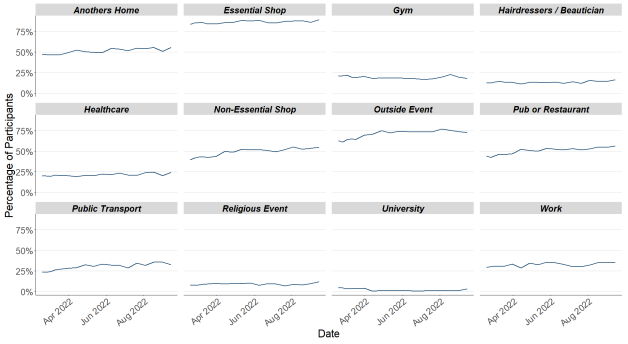
Figure 6 shows the percentage of people wearing a face covering where they have at least one contact outside of the home. This has remained the same at 21% since the last wave of the survey.
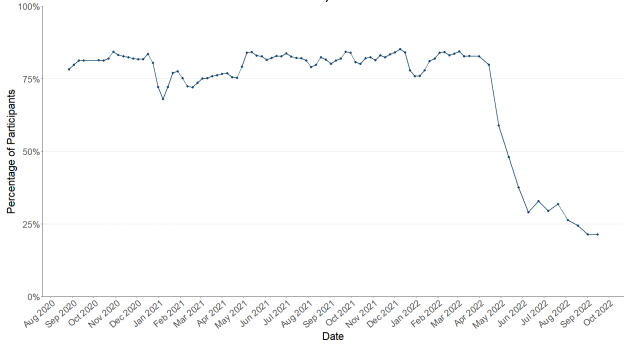
In the survey pertaining to 15th - 21st September, 26% of people had taken at least one lateral flow test in the previous 7 days. This is similar to the previous wave of the survey pertaining to the 1st - 7th September, where the percentage was 25%.
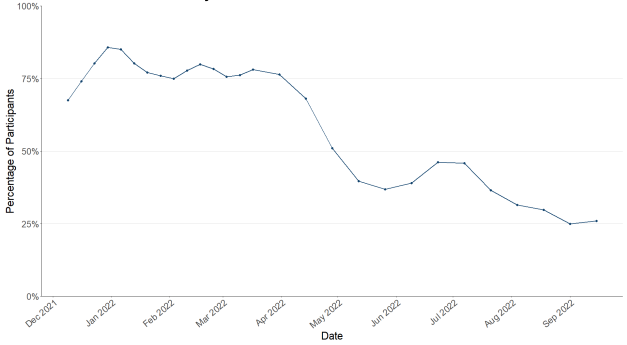
What the modelling tells us about projections of hospitalisations and hospital occupancy in the medium term
SPI-M-O produces projections of the epidemic (Figure 8 and Figure 9), combining estimates from several independent models. These projections are not forecasts or predictions. They represent a scenario in which the trajectory of the epidemic continues to follow the trends that were seen in recent data and do not include the effects of any future policy or behavioural changes. The delay between infection, developing symptoms and the need for hospital care means they cannot fully reflect the impact of behaviour changes in the two to three weeks prior to 26th September. The projections include the potential impact of vaccinations over the next few weeks. Modelling groups have used their expert judgement and evidence from UKHSA, Scottish Universities & Public Health Scotland, and other published efficacy studies when making assumptions about vaccine effectiveness
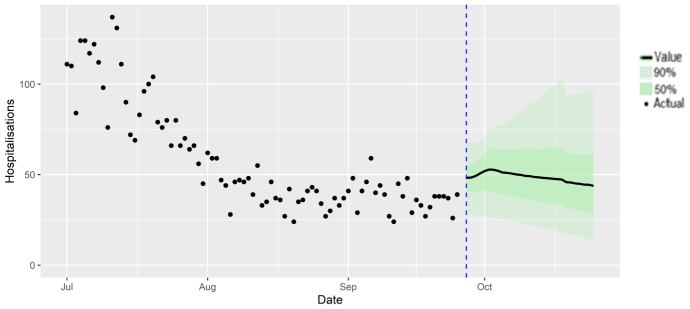
Figure 9 shows the SPI-M-O consensus on hospital occupancy. Hospital occupancy is determined by the combination of admissions and length of stay, the latter of which is difficult to model with confidence.
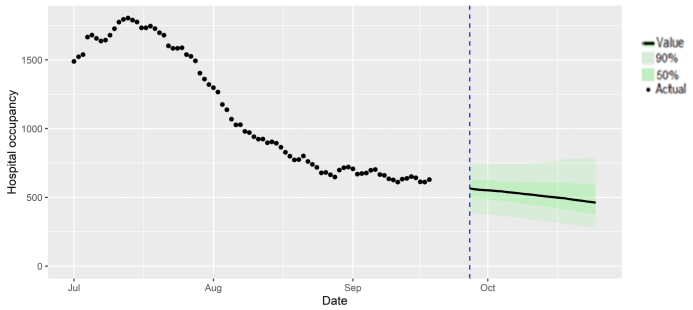
The SPI-M-O consensus view is that by 25th October, daily hospitalisations from Covid-19 in Scotland are estimated to be between 14 and 96, and hospital occupancy is estimated to be between 274 and 790.
Summary of spatial analysis of Covid-19 spread in Scotland
Researchers at the Edinburgh Roslin Institute have conducted spatial analysis of COVID-19 Spread in Scotland. A summary of findings from data up to 21st September 2022 is included here. Note that this analysis uses a recently-updated population estimate.
Rates of LFD and PCR testing are stabilising, albeit at very low levels (1-2 LFD tests reported, per week, per 1,000). PCR testing has fallen (from already very low levels) in recent weeks, with positivity rising
The distribution of lateral flow/LFD tests being reported varies substantially by both age and deprivation status, with many fewer tests reported in younger adults across all deciles of deprivation, and for children in more deprived deciles. There is no longer any requirements for testing in schools and so low reporting is expected, however the high level of LFD positivity in the highest deprivation settings is marked, and when compared to the high number of positives amongst the least deprived, suggests that ascertainment may be lower in younger people in deprived areas.
Fewer tests are reported in younger adults across all deciles of deprivation, and for children in more deprived deciles (with some deciles now reporting zero negative lateral flow tests over the course of a week).
The sharp rise in positivity and numbers of LFD positives reported since 12th September, especially in moderate deprivation deciles and amongst working age adults (Figure 10, considering the week ending 17th September 2022) is suggestive of increased circulation, and a marked change from trends in the previous two weeks (Figure 11).
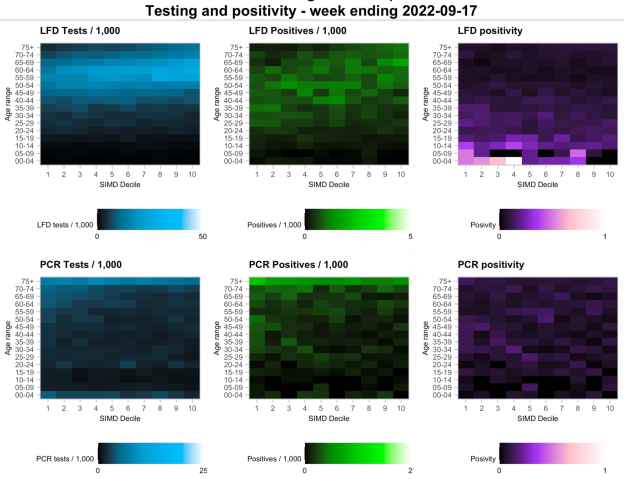
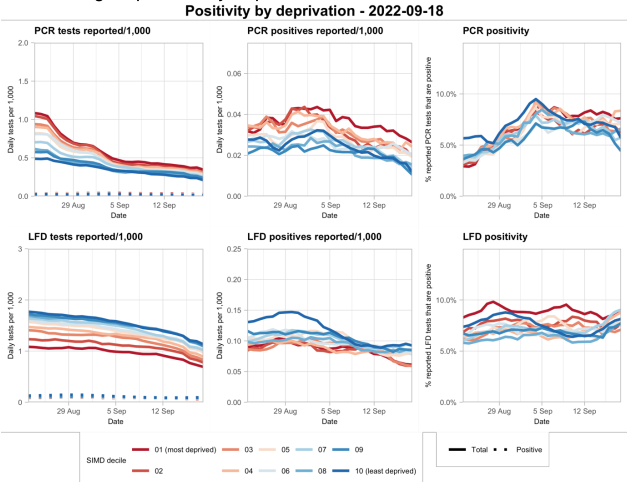
What can analysis of wastewater samples tell us about local outbreaks of Covid-19 infection?
Levels of Covid-19 RNA in wastewater (WW) collected at a number of sites around Scotland are adjusted for population and local changes in intake flow rate (or ammonia levels where flow is not available). See Technical Annex in Issue 34 of Scottish Government Research Findings for the methodology. These reports are based on the most recent data available. Future updates to data may lead to small retrospective changes.
Nationwide, during the period 10th -- 23rd September, wastewater Covid-19 levels remained in the range of 56 to 69 million gene copies per person per day (Mgc/p/d), compared to the previous two-week period (27th August – 9th September) of 52-92 Mgc/p/d.
In Figure 12, we show wastewater Covid-19 RNA levels up to 23rd September 2022, with the ONS Coronavirus Infection Survey (CIS) estimates up to 13th September superimposed. Compared to the previous period, wastewater Covid-19 levels seem lower, though there is no clear evidence of a trend at present. In the CIS data, levels showed a small peak in early September, which may correspond (with a lag) to the peak in wastewater Covid-19 levels around the 1st of September. A similar small increase was seen in hospital admissions around this time.
The most recent days of data show elevated levels, especially in Glasgow, though we have not received corresponding quality control data yet to confirm these values.
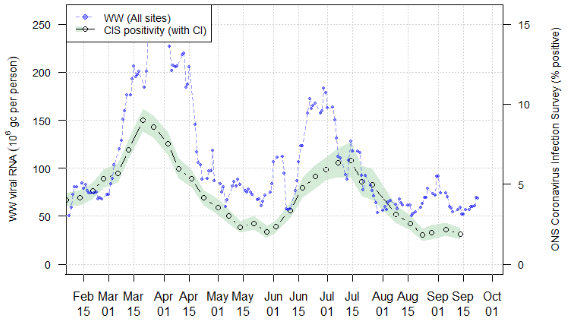
Looking to the future
What may happen in the future around SARS-CoV-2 is uncertain and therefore there are a number of possible Covid-19 futures that may occur in the future. For example, the current Omicron wave may dissipate leaving low levels of Covid-19, or a new variant may emerge potentially having vaccine escape or increased severity, or people’s behaviours may change. One approach to this uncertainty is to model alternative versions of the future through the development of different Covid-19 scenarios.
Given what we know about Covid-19 these possible futures range from a world where immunity reduces Covid-19 hospitalisations and ICU to low levels, through to variant world where a variant with immune escape enters Scotland and Covid-19 hospitalisations and ICU could increase. In between these two extremes there could be possible futures where people’s behaviour becomes polarised between those who continue with Covid-19 precautions e.g. hand washing etc. and those who do not.
The scenarios we provide in the next section look at what could happen for planning purposes, not to forecast what will happen. The assumptions are based on our most up to date knowledge, but do not include the effect of future changes in treatment of Covid-19 e.g. widespread use of antivirals or changes in behaviour in response to high levels of infections e.g. in variant world. Therefore, in the most extreme scenarios the peak may be lower than suggested if behaviour or restrictions changed.
There is no linear progression between the worlds and all are plausible. Each world inherently contains a different threat level requiring a different approach to management.
Immune World
In this possible future vaccines and natural immunity are effective at keeping Covid-19 at low levels. New variants may emerge in Scotland but for the foreseeable future infections are based around Omicron.
Infections may decrease from current levels over the coming weeks and months to very low levels. Likewise hospital and ICU occupancy may follow this trend relieving the pressure on healthcare services. Issues with new variants are not considered in this world and therefore levels of infections remain low.

In Immune world Covid-19 in Scotland reduces below epidemic levels, becoming endemic. Cases of Covid-19 therefore spring up only as rare outbreaks which are controlled through public health measures. People’s lives return to something close to normality e.g. physical distancing is not needed but people still choose to self-isolate and hygiene is good. As vaccines are effective, take-up of first/second/third doses are good and boosters become part of an annual cycle like flu. The numbers of people who need medical treatment or hospitalisation for Covid-19 remain low.
The focus moves away from Covid-19 response and into recovery. This includes addressing learning losses, treating Long Covid and working through the hospital backlog. Wellbeing measures improve with reduced anxiety and increased happiness. Those from the highest risk groups feel they can reintegrate without government interventions. The economy continues to recover from the effects of Covid-19. Travellers do not face significant issues with trips overseas.
Polarised world
In this world, vaccines and natural immunity are effective at reducing infections. The approach followed relies on individual risk assessment and behaviours. However, society becomes polarised as some continue to take up vaccines and follow guidance while others are more reluctant. Covid-19 becomes a disease associated with those who do not or cannot get full vaccine benefit and do not or cannot adopt a risk based approach.
Impacts on hospital/ICU occupancy are uncertain but levels may be higher than what may happen in Immune world (see Figure 14).

Cases of Covid-19 spring up and are hard to control in those who are not vaccinated or vulnerable. People’s lives return to a “new normal” but, due to polarised groups in society with some following and some not following guidance, infections remain.
Vaccines are effective so older and more vulnerable people come forward for future doses in high numbers.
The focus remains on Covid-19 and the shift onto recovery is slower. Existing learning losses are harder to rectify and continue to accrue due to infections within education settings. The hospital backlog is difficult to address as hospitals are still dealing with Covid-19 cases. The population becomes polarised in to those whose wellbeing improves e.g. lower risk people and those whose wellbeing deteriorates e.g. higher risk or poorer people whose levels of anxiety increase as Covid-19 circulates. They continue to experience greater illness, greater poverty or disruption to their income. The economy continues to be impacted from the effects of Covid-19.
Variant world – vaccine escape with same severity as Delta
In this possible future a variant with vaccine escape emerges in Scotland presenting a challenge even for fully vaccinated people. This new variant leads to increased transmission, but not to increased severity compared to previous variants. In this scenario other NPIs may need to be put in place for a short time. This world is similar to what has happened in Scotland with the emergence of Omicron.
Omicron may be reduced to low levels within Scotland as a new variant takes over. This causes a new wave of Covid-19 infections as well as increases in hospital and ICU occupancy. People’s lives are disrupted due to the increasingly high levels of infections leading to time off work ill or isolating.
To show the potential impact assume a new variant appears in Scotland in the October holidays as people return to work and school. The timing is uncertain and a potential new variant may appear sooner than the summer or significantly later but has currently been lined up with the summer holidays to show illustratively what could happen. The new variant may cause Omicron infections to decrease significantly or disappear entirely (and is not shown). The new variant is modelled with similar transmissibility and vaccine escape as Omicron with severity characteristics similar to Delta. It could lead to high levels of infections leading to hospital occupancy rising above capacity restrictions. With sustained high levels of infection we could again see increased staff absences in a number of sectors that were affected by this in the recent Omicron wave.

The focus remains on Covid-19 and it is hard to shift on to recovery. Continued infections within education settings and staff shortages may impact schools. The Covid-19 strain on hospitals is high due to the very high numbers of infections and workforce pressures grow making it difficult to address the hospital backlog. Wellbeing measures deteriorate with people reporting low happiness and general ‘tiredness with it all’. The economy continues to be impacted from the effects of Covid-19 with many people off work. Travellers may not want to come to the UK as the new variant sweeps through .
Variant world – vaccine escape with increased severity compared to Delta
As with the other example of Variant world, a new variant appears in Scotland in the October holidays as people return to work and school. The timing is uncertain but has currently been lined up with the summer holidays where reduced travel restrictions may make it more likely that a new variant is brought into Scotland.
The new variant may cause Omicron infections to decrease significantly or disappear entirely (and this is not shown on the graph). It is modelled with similar transmissibility and vaccine escape as Omicron with severity characteristics 50% higher than Delta, purely for illustrative purposes.
It could lead to high levels of infections leading to hospital occupancy rising significantly. With sustained high levels of infection we could again see increased staff absences in a number of sectors that were affected by this in the recent Omicron wave .

The focus remains on Covid-19 and it is hard to shift on to recovery. Continued infections within education settings and staff shortages may impact schools. The Covid-19 strain on hospitals is high due to the very high numbers of infections and workforce pressures grow making it difficult to address the hospital backlog. Wellbeing measures deteriorate with people reporting low happiness and general ‘tiredness with it all’. The economy continues to be impacted from the effects of Covid-19 with many people off work. Travellers may not want to come to the UK as the new variant sweeps through.
What next?
Archiving of models is currently being undertaken via the Data Science Scotland GitHub organisation. Details of the Scottish Contact Survey contact matrices are available. See the Technical Annex of issue 96 for details of other archived models.
Contact
There is a problem
Thanks for your feedback